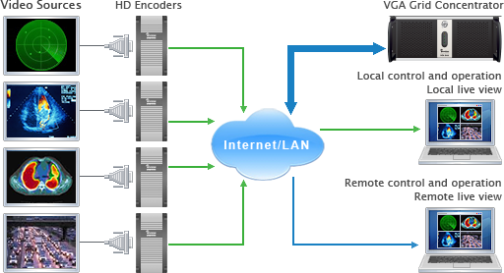Networked VGA Grid Overview
Epiphan's VGA Grid allows you to capture, stream, and record audio and video from a large number of VGA, DVI, HDMI, composite and component sources. It supports streaming to a large number of viewers using industry-standard codecs such as H.264 and MPEG-TS. VGA Grid is suitable for a broad range of applications.

This versatile system has a variety of options enabling you to create and configure any number of streaming channels. You can choose to stream (or record) a single channel at once or a configuration of synchronized channels with picture-in-picture or picture-with-picture multiplexing selections.
The VGA Grid comes in two styles to meet your needs: Networked and Standalone. The Standalone VGA Grid captures video and audio through internal cards. Depending on the model, it has 4 or 6 DVI source ports, 4 or 6 SDI source ports and 4 or 6 S-Video source ports. The latest hardware models (with SDI capture) also support HDMI and SDI audio capture. Encoding and synchronization of the stream is done locally on the Standalone VGA Grid. The Networked VGA Grid has no internal capture cards, instead it uses VGA Grid HD Encoders to capture and encode sources, sending the already encoded stream to the VGA Grid. Using external encoders means the VGA Grid has less stress on its CPU so it can handle a greater number of inputs. HDMI audio capture and SDI video capture are not supported with Networked VGA Grid systems.

